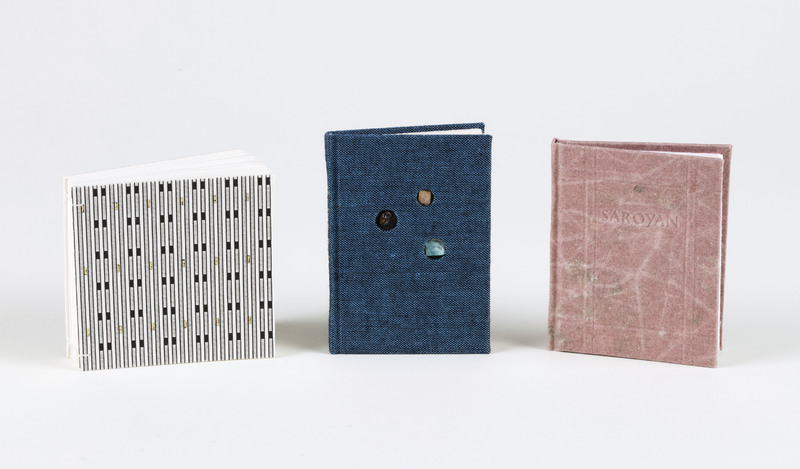A65. The Pretty Rocks
(Middle) A65. Suzanne Thomas. The Pretty Rocks. Santa Cruz, California: Peter & Donna Thomas, 1991.
74.5 x 54 mm (2 15/16”x 2 1/8”), 12 pages, 150 copies.
Binding: Full-bound in blue cloth over boards. Three small polished stones inset in holes on cover. End sheets off-white with bits of colored paper. Title in gold on spine. Paper: White, handmade by Peter Thomas. Printing: Letterpress. Text printed from photoengraving. Typography: Reproduction of text handwritten by Donna Thomas. Illustration: Reproductions of three drawings by Suzanne Thomas; printed in six colors. Linocut tint blocks by Donna Thomas. Notes: Miniature Book Society Distinguished Book of the Year, 1992.
“This book is a miniature rendition of a manuscript book made in school by Suzanne Thomas (then age 6). Using phonetic spellings, Suzanne tells a story of an angel taking a walk to find pretty rocks. Donna used Suzanne’s original, which was larger and proportioned slightly differently, as a guide while she wrote out the text and recreated the illustrations, trying to remain as true as possible to the original. This was the first time we printed a book with multiple color runs for the illustrations.”
(Right) A66. William Saroyan. Saroyan. Santa Cruz, California: Peter & Donna Thomas, 1991.
74.5 x 74.5 mm (2 15/16”x 2 5/16”), 14 pages, 150 copies.
Binding: Red paper with various fibers, handmade by Peter Thomas, crinkled over boards. Bas-relief on cover. Title blind-stamped on cover. End sheets red. Paper: White, handmade by Peter Thomas with text in watermark. Shades of red with various fibers, handmade by Peter Thomas, layered behind white text pages. Printing: Letterpress. Typography: Hand set Paramount. Watermarks. Illustration: One U.S. postage stamp with picture of Saroyan. Note: The single sheet of watermarked paper used for the text was printed on both sides: the paper was then folded vertically in half and horizontally in half, then each half in half again, creating 8 pages. A slit was then made along the vertical fold from the first horiziontal fold to the third fold, and then the sheet was folded to create what appears to be an eight-page booklet made of two nested French-folded pages, sometimes called the “O” cut folded book, or an 8-fold accordion.
“For years we had thought of making a book with a postage stamp for an illustration. Seeing the Saroyan postage stamp, we decided to read more of what he had written and find a suitable quote. When we found this quote Peter saw the perfect opportunity to do something he had wanted to do for years— make a book with the text in watermarks. To make the watermark he took plastic letters from the message board in the lobby of a nearby hotel and slipped them into the laid mould, just as they were meant to slip into the message board. The intricate method used to fold the text paper was not necessary, but done because it added to the visual complexity of the project.”
(Left) D3. Beth Regardz and Warren Stringer. Patterns from Chaos. Santa Cruz: California. Peter & Donna Thomas, 1991.
75 x 75 mm (2 15/16”x 2 15/16”), 56 pages, 50 copies.
Binding: Non-adhesive Coptic binding. Covers are Rococo-patterned paper laminated to black cardboard. Housed in a clamshell box covered in metallic blue cloth. Paper: White, handmade Japanese Torinoko. Printing: Letterpress; printed from photo engravings. Typography: Digital Janson, set by Beth Regardz. Illustration: Ten samples of Rococo-patterned papers, laser printed on handmade colored Japanese Moriki paper using multiple layers of metallic foils. Notes: Made by Peter and Donna Thomas in collaboration with Beth Regardz and Warren Stringer in Santa Cruz, California.
“The concept of ‘chaos theory’ and cellular automata was developed in Santa Cruz at University of California Santa Cruz by Ralph Abraham and colleagues. Warren Stringer wrote original code in Santa Cruz based on these concepts, using a PC that was connected to a laser printer. To create the images each sheet of Moriki paper was passed through the printer two times for each color (once to apply the toner and once to fuse the metallic foil to the paper). Thus an image with three colors passed thru the printer six times. Beth Regardz taught Illustrator and PageMaker at University of California Santa Cruz Extension in the late '80s, then in 1992 co-founded the Cabrillo College Digital Media program where Peter took his first computer classes from her. Peter and Donna collaborated with Regardz and Stringer on the concept and design for this book and they both printed and bound it. The text pages were designed by Regardz on a Mac computer and then printed from polymer plates. This was one of the first, if not the first, miniature books printed using polymer plates.”
